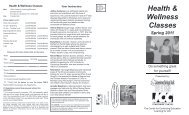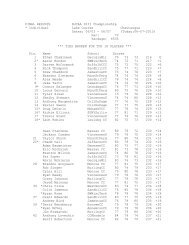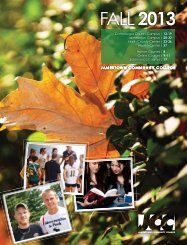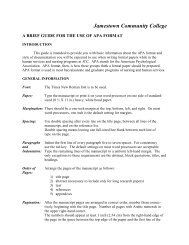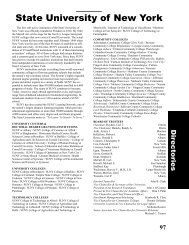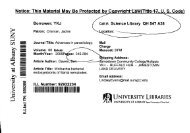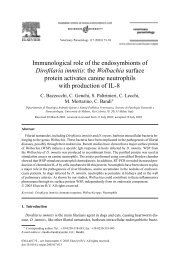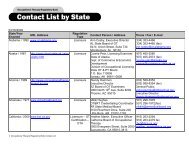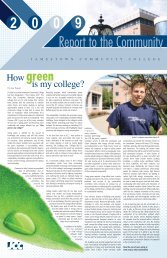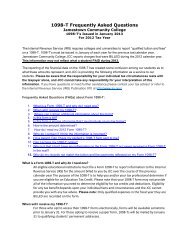JCC Brand Book (PDF) - Jamestown Community College
JCC Brand Book (PDF) - Jamestown Community College
JCC Brand Book (PDF) - Jamestown Community College
You also want an ePaper? Increase the reach of your titles
YUMPU automatically turns print PDFs into web optimized ePapers that Google loves.
EDITORIAL GUIDELINES<br />
dates<br />
• Use month-day-year sequence (omit the year if it’s<br />
obvious).<br />
• Use cardinal, not ordinal, numbers: June 30, not<br />
June 30th.<br />
• Do not separate month and year sequence with a<br />
comma: September 2003.<br />
• Use commas to set off the year when using full dates.<br />
Example: She was born June 7, 1982, in Salamanca.<br />
• Do not use commas when using only month and<br />
year constructions. Example: Planning began in<br />
May 2009.<br />
• Do not use 1st, 2nd, etc., with dates. Right: January<br />
5, October 23. Wrong: January 5th, October 23rd.<br />
• Use the year if not the current calendar year.<br />
Examples: Ed and Sally McCormicks were married<br />
in April 2001. The McCormicks were married in<br />
April.<br />
• Periods of years. Examples: She worked from 1968<br />
to 2001. She worked in the 1970s (if a decade);<br />
avoid ’70s.<br />
deans’ list<br />
• Do not capitalize. Since <strong>JCC</strong> has two deans issuing<br />
the list, it is deans’, not dean’s.<br />
departments<br />
• Academic: Use lowercase for informal reference<br />
(business and social sciences division) but capitalize<br />
for formal reference (Arts, Humanities, and Health<br />
Sciences).<br />
• Administrative: admissions offi ce, alumni affairs<br />
offi ce, student development offi ce, registrar’s offi ce.<br />
• Capitalize the formal name: Hultquist Library,<br />
Center for Continuing Education, Main Street.<br />
dollar amounts<br />
• Use a dollar sign followed by a numeral. Do not<br />
use .00 with dollar values. Examples: $250 (not<br />
$250.00), $12,300, $5.3 million (not $5,300,000).<br />
e.g./i.e.<br />
• The abbreviation e.g. means exempli gratia, or “for<br />
example.” It should be punctuated with periods<br />
and set off with commas. Example: Representatives<br />
from various areas (e.g., criminal justice, business,<br />
engineering) were among the conference<br />
participants.<br />
• The abbreviation i.e. means id est, or “that is.” It<br />
is for listing the specifi c case(s) referred to in the<br />
preceding material. It should be punctuated with<br />
periods and set off with commas. Example: Please<br />
e-mail your vote, i.e., aye or nay.<br />
electronic addresses<br />
• No spaces between characters.<br />
• No period at end unless it’s the end of a sentence.<br />
• All lowercase.<br />
• Break an electronic address on either side of a slash<br />
(keep two slashes together) or at a period, which<br />
goes at the beginning rather than at the end of a line.<br />
• Don’t break at a hyphen (or, if necessary, break<br />
before, not after, a hyphen), and never add a hyphen.<br />
JAMESTOWN COMMUNITY COLLEGE BRAND BOOK<br />
e-mail<br />
• Use the hyphen.<br />
English as a second language<br />
• Capitalize only English, but the acronym is ESL.<br />
exclamation point<br />
• Frequent use of the exclamation point for emphasis<br />
is not recommended, nor is multiple use, i.e. “Come<br />
join us!!!!!!”<br />
faculty/staff<br />
• These are singular nouns, referring to groups. When<br />
used alone, treat it as a singular noun. To make it<br />
plural, use “faculty members.” When referring to<br />
the people who make up the faculty, use “faculty<br />
members.” Examples: Our faculty is the best. All of<br />
our faculty members teach multiple classes. Also,<br />
“the staff is,” but “staff members are.”<br />
fax<br />
• Use lowercase letters (or capitalize the fi rst letter if<br />
starting a sentence or line of formatted text with it).<br />
• Do not use all caps.<br />
fewer/less<br />
• In general use “fewer” for individual items, “less<br />
than” for bulk or quantity. Examples: Fewer than 20<br />
people applied. I had less than $200 in my account.<br />
(An amount.) I had fewer than 20 $1 bills in my<br />
wallet. (Individual items.)<br />
41



